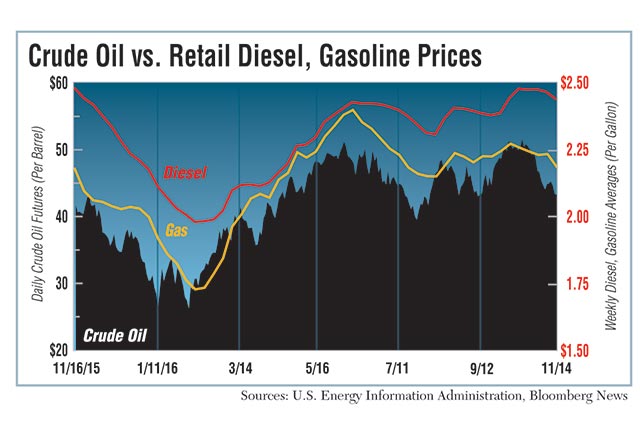Senior Reporter
Diesel Drops 2.7¢ to $2.443; Gasoline Falls 4.9¢ to $2.184

This story appears in the Nov. 21 print edition of Transport Topics.
The U.S. average retail price of diesel fell 2.7 cents a gallon to $2.443, according to the Nov. 14 survey by the Department of Energy, while crude oil prices continued their slide since the presidential election.
The diesel average is 3.9 cents less than a year ago, when the price was $2.482, DOE’s Energy Information Administration reported. Diesel prices were lower in all regions of the nation.
Also, the U.S. average for regular gasoline dropped 4.9 cents a gallon to $2.184, 0.6 cent higher than a year ago, EIA said. The average price of gasoline also was lower in all DOE regions.
Crude oil futures on the New York Mercantile Exchange closed Nov. 16 at $45.33 per barrel, up from $45.27 on Nov. 9.
The cost of crude oil accounts for 43% of the price of a gallon of diesel and 47% of the cost of a gallon of gasoline, EIA said.
Although fuel prices generally have been manageable this year, they are still of great interest to fleet managers.
The key to controlling fuel costs is managing three relationships at once, said Gerry Mead, senior vice president of maintenance at truckload carrier U.S. Xpress Inc., a unit of U.S. Xpress Enterprises.
“One is the right [fuel] supplier, getting a great relationship out there,” Mead told Transport Topics. “Two is concentrating on usage through your miles per gallon through driver education, and the third is the right specifications in the trucks.”
Chattanooga, Tennessee-based U.S. Xpress partners largely with one truck stop chain but does use all of them, he said. The company operates about 6,800 tractors.
“The first part is negotiating the price,” Mead explained. “Secondly, your driver influences the fuel economy the most. No matter what system you have, the driver is still going to be a big component of it. Some will say 30% to 35%. I say it’s right in there between those two.”
Finally, “It’s your equipment, from the [original equipment manufacturer] piece, down to your engine, the right tires and the proper preventive maintenance programs,” he said, adding that an improvement of one-tenth of a mile per gallon when fuel is $2 a gallon is $400 per truck over a year.
“If you put all three things together, it is a total team effort, and you can manage your fuel costs like never before,” Mead said.
U.S. Xpress Enterprises ranks No. 19 on the Transport Topics Top 100 list of the largest U.S. and Canadian for-hire carriers.
EIA published its latest Short-Term Energy Outlook on Nov. 8 and said the retail diesel average is expected to increase to $2.60 a gallon in the first quarter of next year and then to $2.82 in the fourth quarter.
The agency also expects gasoline prices to fall to an average of $1.97 a gallon in January. Retail gasoline prices are forecast to average $2.27 in 2017, up from $2.13 this year, EIA said.
The outlook also said West Texas Intermediate crude oil prices will climb to $50 a barrel in 2017 from $43 this year.
When a new president is elected, the price of oil generally slides in the weeks just after Election Day, gaining after Inauguration Day in January or as the swearing into office draws near, according to S&P Global Platts, a provider of information and benchmark prices for commodities and energy markets.
“With a goal of making the U.S. energy-independent, [Donald] Trump eyes American energy dominance as a strategic economic and foreign policy goal. Such a nationalistic approach, combined with a viewpoint unconcerned with climate change, bodes well for oil and gas producers,” Platts posted online Nov. 9.
Nymex crude futures contracts and options are the among the more actively traded commodity derivatives, EIA said, involving many producers, consumers — including refiners, airlines, trucking companies and fuel distributors — and other investors and risk-takers, EIA said.
In terms of supply, OPEC nations are scheduled to meet Nov. 30 to discuss limiting production levels to lift prices.
“While there may well still be an OPEC deal outcome in Vienna this month, it is expected to fall short of what is required to really kick-start the rebalancing process,” Harry Tchilinguirian, head of commodity markets strategy at French bank BNP Paribas’ London office, told Bloomberg News.
Bloomberg reported that failure by OPEC to implement a deal could drag down crude to as low as $35 a barrel, PIRA Energy Group Executive Chairman Gary Ross said, while success at the organization’s gathering in Vienna may push oil to $60.




